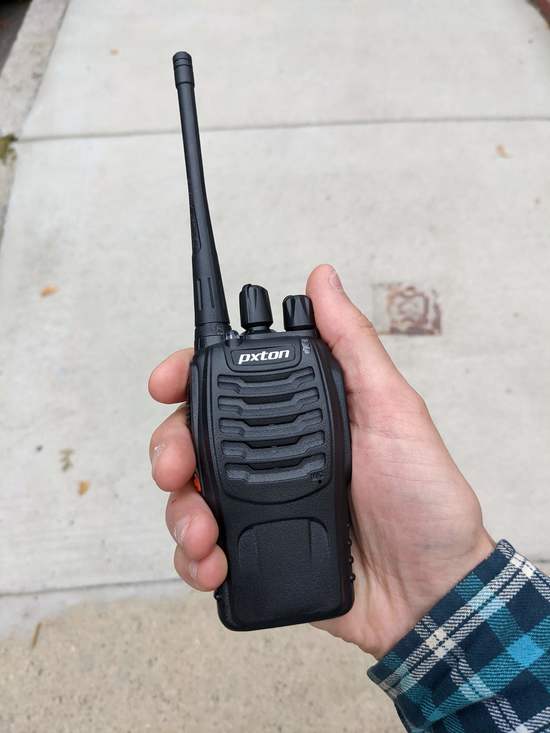In the discussion on kids roaming a few weeks ago, Cullyn suggested walkie-talkies as a way to keep in touch with kids who are out of sight. This wasn’t something I had thought about at all: my only experience had been with short-range children’s models in the early ’90s, but now you can get rechargeable ones that will reach about 1/4mi through houses for ~$13/each shipped.
I got a set of four a little over a week ago, and we’ve been trying them out:
We started with a lot of playing with them in situations where they’re not really needed, with the kids running ahead or something.
Before using them each time, we test them to make sure we have them set up right.
Other kids want to play with the walkie-talkies, but will be rough and change the settings. We ended up needing to make a rule that they weren’t for sharing.
We’ve practiced setting the channel and volume several times, in case they do get messed up.
While I can clip mine onto my belt, or put it in my pocket, the kids rarely have appropriate clothes for that. Julia got a small fanny pack for Lily, and tweaked it to fit better.
Initially, we’re only using them for short times and distances, at a range where I would be OK just walking over and checking on them every few minutes.
Lily (7y) is much better at using them than Anna (5y). I don’t think I would let Anna go very far with one unless it was to meet Lily.
These particular ones speak their settings out loud as you change them, which the kids really like. On the other hand, the knobs are quite hard to read, so Julia painted a white stripe on each so you can see their setting at a glance.
We tested the range, and in our flat neighborhood of densely packed three-story wooden buildings it was clear at 1,200ft, down to almost unusably fuzzy at 1,500ft. This is farther than we are OK with the kids going, and farther than their friends’ houses, so I don’t expect it to be an issue for a while.
Before deciding to get these, we had also considered a watch with cellphone + GPS like the Gizmo. That seems like a nice idea, and I liked the idea of GPS, but it’s more fragile, more expensive up front, and has ongoing costs. Since the walkie-talkie was so much cheaper, we decided to give that a try and see how we liked it. So far so good!
Comment via: facebook

We also used walkie-talkies when our boys were in that age range. But it is more a transitional thing. They will (need to) use it less and less as you gain mutual trust. And later they will want smartphones anyway.
Makes sense! I’d be surprised if Lily if still using these in two years.
It seems like what you really need is walkie-talkie technology in a watch form factor. I’m kind of surprised I’ve never heard of such a thing.
Walkie-talkies need to be pretty powerful; I bet that’s too bulky for your wrist?
I don’t think it’s an impossible idea! XBEE radios in the form factor of a large watch can give you 200 kbps at 1000 ft in an indoor/urban environment, drawing 229 mA at 3.3 V. That seems to be about twice the data rate needed for clear voice communication. A 400 mAh li-ion battery is about 1x1.5 inch, so in the right ballpark. Add a 1⁄4 watt for a mini speaker and you’d get you about 25 minutes of talk time, and if you halved the data rate, you’d get 1500 ft of range. It would be pretty unwieldy and probably not quite the performance you’d hope for if you tried to hack it together from hobbyist parts, but a proper manufacturer just might be able to make it work.
The only part I’m not too sure about is antenna design. The 970 MHz XBEEs are usually run with bulky duck antennas, which wouldn’t work in a watch form factor. There are definitely designs out there for embedding antennas in wrist straps, but I don’t know much about what kind of pattern you’d get.
I don’t think digital is allowed? For example, these walkie-talkies use FRS which is FM
Hmm I think you’re right that digital voice protocols aren’t allowed on in 462-467 MHz FRS band. But there are a couple regions of the 900-1000 MHz portion of the spectrum that are allocated to commercial two-way radio, which allows digital and might be usable for this application if you were trying to actually manufacture and sell this kind of product.
If one were trying to do this as a homebrew project, either the 902-928 MHz ISM band used by the XBEEs or the 420-450 MHz band used for ham radio could work (with a ham radio license).
I think at that point you might as well use a cell phone watch?